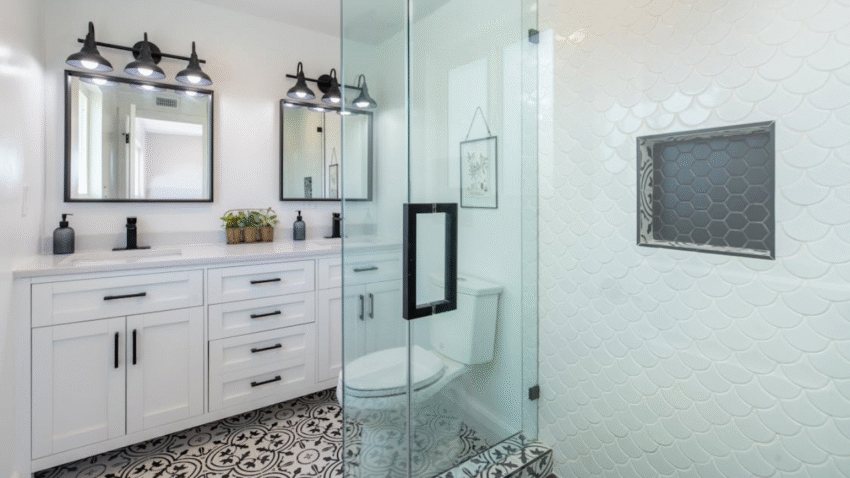Introduction
Tired of dingy, discolored grout lines ruining the look of your bathroom? This step-by-step guide on how to clean grout in the bathroom will help you restore your tiles to their original brilliance. Whether you’re battling stubborn mildew, soap scum, or just years of buildup, we’ve got simple techniques that actually work — no harsh scrubbing required.
Why Cleaning Grout Matters in the Bathroom
Grout may seem like a minor detail, but it plays a huge role in your bathroom’s cleanliness, appearance, and hygiene. Because it’s porous, grout easily absorbs moisture, dirt, and bacteria, which can lead to mold growth and unpleasant odors. Left unchecked, dirty grout can stain permanently, degrade the surrounding tiles, and even affect indoor air quality due to trapped mildew in humid environments. Keeping your grout clean enhances not just your bathroom’s aesthetics but also prevents long-term water damage and promotes a healthier space for you and your family.
Step-by-Step Guide to Cleaning Bathroom Grout
Follow these steps to deep-clean grout and bring your bathroom tiles back to life:
1. Gather Your Supplies
You’ll need a grout brush or old toothbrush, baking soda, white vinegar (or hydrogen peroxide), a spray bottle, warm water, and a clean cloth. For heavy-duty jobs, a steam cleaner or commercial grout cleaner may be helpful. Always test a small area first to avoid damage.
2. Make a DIY Grout Cleaner
In a bowl, mix baking soda and water into a thick paste. This non-toxic cleaner breaks down grime without harsh fumes — perfect for bathroom use where ventilation can be limited.
3. Apply the Paste to the Grout
Using your brush, apply the baking soda paste directly onto the grout lines. Make sure to cover all the stained or dirty areas thoroughly. Let it sit for at least 10–15 minutes so it can penetrate deep into the pores.
4. Spray with Vinegar or Hydrogen Peroxide
Next, spray a solution of equal parts white vinegar and water onto the grout paste. (Use hydrogen peroxide instead of vinegar if your grout is sealed — vinegar can degrade sealant over time.) The mixture will fizz on contact, lifting grime and mildew to the surface.
5. Scrub Gently
After the bubbling stops, scrub the grout lines with your brush in a circular motion. Use moderate pressure to remove buildup without damaging the grout. Pay extra attention to corners and spots near the shower or tub where mold tends to accumulate.
6. Rinse and Wipe Clean
Wipe away the dirty residue with a damp cloth. Then rinse the area with warm water to remove any leftover paste or cleaner. Dry with a microfiber towel to prevent water stains or moisture buildup.
7. Seal the Grout (Optional but Recommended)
Once your grout is clean and dry, apply a grout sealer to protect it from future staining. This step is especially important in high-moisture zones like the shower, around the sink, and near the toilet base.
Common Mistakes to Avoid
Avoid these pitfalls to get the best results and extend your grout’s lifespan:
- Mistake: Using bleach on all grout types
Solution: Bleach can degrade grout and tile if overused. Stick to natural or pH-neutral cleaners for routine cleaning. - Mistake: Scrubbing with wire brushes
Solution: Metal brushes erode grout. Use nylon or soft-bristle brushes to clean safely. - Mistake: Not testing cleaners first
Solution: Always spot-test in a hidden area to ensure your cleaner won’t discolor or damage your tiles. - Mistake: Skipping regular maintenance
Solution: Clean grout monthly to prevent buildup and reduce the need for deep cleaning. - Mistake: Forgetting to dry the area
Solution: Moisture encourages mold. Dry the grout after rinsing to prevent mildew from returning.
Extra Tips & Bathroom Hacks
- Use a steam cleaner for moldy grout: If traditional scrubbing doesn’t work, a handheld steam cleaner can blast away mold and grime with zero chemicals.
- Add essential oils to your spray bottle: A few drops of tea tree oil or lavender oil not only help kill bacteria but also leave your bathroom smelling fresh.
- Keep grout clean longer with daily maintenance: After each shower, wipe down tiles with a squeegee and keep the fan on to reduce humidity buildup.
Need more bathroom upkeep help?
👉 Check out our guide on how to fix a leaky bathroom faucet to prevent water from seeping into your grout lines!
Conclusion
Cleaning grout in your bathroom doesn’t have to be a frustrating or time-consuming task. With a little baking soda, vinegar (or hydrogen peroxide), and elbow grease, you can refresh your tile lines and make your entire bathroom feel brand new. Don’t forget to seal your grout for longer-lasting results — and give it a quick touch-up each month to keep mold and stains at bay.
Bookmark this guide so you can keep your bathroom fresh, clean, and problem-free all year round.
